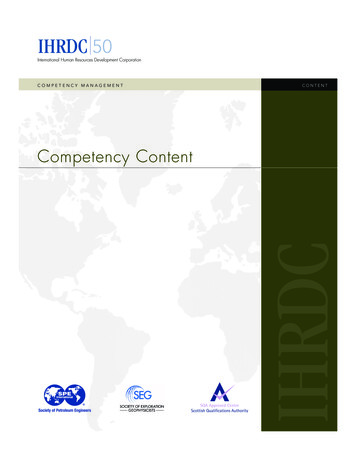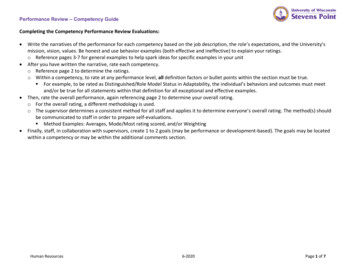
Transcription
STRATEGIC INTELLIGENCE WITH BI COMPETENCY CENTERStudent Rodica Maria BOGZA, Ph.D.The Bucharest Academy of Economic StudiesABSTRACTThe paper is about the strategic impact of BI, the necessity for BI and how BI would drive thesuccess of an organization. It will continue emphasizing the way in which new technologiesand ideas emerge in the business world.BI is a strategic initiative by which organizations measure and drive the effectiveness of theircompetitive strategy. In achieving this grand goal, there is need for analyse, software,resources, technical leadership, process leadership, executive champions and much more. Itis a long term process and it can be broken down to goals, which are periodically analysedfor a good manage of resources and growth. An effective way of creating and managing BI isto start with a BI competency center. The BI competency center's (BICC's) role is tochampion the BI technologies and define standards, as well as the business-alignment, projectprioritization, management and skills issues associated with significant BI projects.A BI competency center at least must have a BI leader dedicated to acceptance and success ofthe BI initiative. There must be at least three key leaders under the BI leader: datamanagement leader, business process leader and project management leader, each havingtheir responsibilities and role. In order to implement a competitive strategy, the executiveteam establishes tactics and tasks that are materialized into several projects across theorganization. The effort of the BI competency team is to identify the metrics and data sourcesrelevant to the matter, for obtaining the desired goal. The effort required to accomplish thesegoals are above and beyond the responsibilities of a typical IT organization becauseinvolvement is needed from other departments. BI competency centers bring additional boostto the productivity of the IT organization. As organizations are facing several complexdecisions every day, the investment in a BI competency center becomes easily justifiable.KEY WORDSBI competency center, BI leader, Data Management leader, business process leader, projectmanagement leaderBI VERSUS GUT FEELThe key to this vital knowledge lies in the huge amount of data that every organizationalready collects. BI uncovers a lot of competitive advantages by transforming that raw datainto actionable intelligence and by creating knowledge to implement winning strategies anddeliver information that can be leveraged by the entire organization.One of the greatest inhibitors to competitive advantage is acting solely on ‘gut feel’ and‘intuition’. The decisions based on what someone feels can not be measured , repeated, sharedor easily understood. The specialized knowledge needs to be joined with the data to improvefuture decision making and provide competitive advantage.66
CRITERIA FOR TRUE BUSINESS INTELLIGENCEBREADTH: It integrates functions and technologies from across the organization. IntegratedBI integrates data from every corner of the organization – from operational/transactionalsystems, multiple databases in different formats, and all contact channels. The informationflow can transcend organizational boundaries, computing platforms, and specialized tools.DEPTH : It reaches all who need it, in a way that is relevant to them. A real BI solutionprovides appropriate interfaces and tools for users at different levels of organization, whohave different needs. The results of analysis should be easily disseminated across allfunctional areas and organizational levels.COMPLETENESS: It is a comprehensive, end-to-end platform. BI is not just query andreporting. It depends on a chain of applications and technologies working together from acommon data foundation to create a single version of truth.ADVANCED ANALYTICS: It delivers predictive insights, not just hindsight. OnlineAnalytical Processing (OLAP) is a valuable part of the picture, but isn’t the only source ofcompetitive differentiation. BI requires not only historical query and reporting, but predictiveanalytics, such as scenario planning, forecasting, optimization and risk analysis.DATA QUALITY: Data is vital to the decision making process, and ensuring that one has theright data is imperative. The quality of data affects directly the return on BI investment.INTELLIGENCE STORAGE: it meets the information needs of intelligence applications.The data storage platform must be able to draw on information from many sources, prepare itfor analysis, and deliver it quickly to the applications and platform that need it.Bi is not only about software. The success of BI projects is sustained by a proper environmentfor BI, which includes the appropriate processes, the people with in-depth BI skills, and anorganizational culture focused on fact-based decision making.BICCThe challenges in exploiting Business Intelligence can be defined in six categories :Data challengesTechnology challengesProcess challengesStrategy challengesUsers’ challengesCultural challengesDATA CHALLENGES: Data are the heart of all BI initiatives. The data required and the timeand effort necessary to collect the necessary data and to ensure their accuracy are oftenunderestimated. Data issues are most costly element of BI implementation. It takes a lot oftime, resources, and effort to identify, map, and create the necessary rules and processes toensure that data are used consistently and accurately across the organization, promoting asingle version of truth.Usually, the disparate data sources don’t speak to each other, and each might be managed bydifferent groups that report to different organizational entities. Once data have been correctlyidentified and collected, data quality has to be considered. Ignoring this would be a costlymistake. Analysis must take place to ensure that the data collected are correct and suitable fordecision-making processes. It’s better to insert a data quality process to the source of data.Resolving data quality issues requires communication and working together with variousgroups and experts to resolve the root causes and underlying issues. Therefore, one has to67
include a data stewardship function into the BICC, where the data quality topics can beadequately addressed.Data storage is another obstacle for BI. Data often are stored in multiple formats, in multipleplaces, and in multiple databases. Data must be accessed and consolidated into consistentbusiness views that support a fit-for-use approach for delivery despite storage complexitiesand limitations.TECHNOLOGY CHALLENGES: The proliferation of disconnected information silos posesobstacles to the successful creation of knowledge within an organization. Since individualdepartments have been run like separate business and often used disparate hardware,platforms, system standards and databases, the BICC has to provide means of addressing thewhole information value chain. Often the success of a particular piece of BI technology restsnot only on its use in the organization, but on what precedes it in the value chain. Over time,organizations have accumulated a complex set of heterogeneous tools and infrastructuretechnologies that are not very well integrated. The BICC plays a key role in balancingcorporate governance while providing the flexibility required to get the job done.PROCESS CHALLENGES: BI is a process, not a software product. Processes can bechanged and measured and are documented, making them repeatable and able to adapt tochanging business requirements. And the key to successful processes is people. Organizationsthat marry their human capital, culture, knowledge processes, and infrastructure by creating aBICC are prepared and poised to meet the continuously changing demands of their customersand maximize potential.STRATEGY CHALLENGE: The goal is to align all BI initiatives in order to support theorganizational strategy. But, different groups in the organization have different BI needs andstart their own independent BI projects. The BI strategy represents the way in whichinformation delivery needs from management and operations are addressed and met.USERS’ CHALLENGES: BI can enhance everyone’s decision making across theorganization. Understanding the different audiences and their information needs, skills andgoals is vital for the success of a BI implementation. A BICC can help to identify the differentaudiences, to understand their needs, to shape their requirements and training, and coach themso that they can drive the right conclusion from the data available to them. The goal is to useBI to its greatest effect and to raise the overall maturity of the organization.CULTURAL challenges: the culture that can be a great inhibitor, needs to be such that itencourages fact-based decision making- that is, people can get to the information they need tomake their decisions in an easy and timely fashion. The BICC can contribute to understandthe culture of the organization and to leverage it for its best advantage, so that the strategicuse of information becomes a core competency for the organization.WHAT IS A BICC ?BICC is a a cross-functional team, with a permanent, formal organizational structure. It hasemployees from the organization itself, although some roles can be outsourced. The BICC hasthe task of driving the use of BI throughout the organization, making it available to businessusers at different levels and providing advice and support for all BI-related questions,including assistance with the interpretation of information.A BICC enables the organization to coordinate and complement existing efforts in the area ofBI, while reducing redundancy and increasing effectiveness. The centralization of these68
efforts ensures that information and best practices are communicated and shared through theentire organization so that everyone can benefit from successes.A central mandate for the BICC is to enable knowledge transfer and enhance analytic skillsand enable the business units to meet their goals. The BICC can coach and train businessusers to empower them with new skills that drive competitiveness. It can be instrumental inturning analysis into action and ensuring higher levels of ROI from BI.Arguments for establishing a BICC Preserve and exploit the full value of technology investments Integrate and consolidate business and analytical intelligence processes and initiatives Reduce overall risk of implementation projects and project realization Support business users in fully understanding data and acting properly on analyses Ensure that BI knowledge (BI value, concepts and technology) is shared in theorganizationThe BICC should be the ‘center of gravitation’ , where different skill sets are combined forone common goal : to understand better the business and interpret current business results andpredict the future more accurately. In order to do this, a combination of business, IT, andanalytical skills is required.Generally the BICC is placed in an organization in the IT division or in the MIS division, inboth cases doing reports to business management.AXES OF A BICC : Business needs Organization and processes Tools and application Data integration and managementNECESSARY SKILLS FOR A BICC:RESPONSIBILITY AREAS of a BICCKnowledge managementBusiness-related consultingAnalyticsData warehousingEnterprise data model managementTrainingHelp deskIntegration process management69
FUNCTIONAL AREAS INSIDE THE BICC********Business intelligence programData stewardshipSupportBI deliveryData acquisitionAdvanced analyticsTrainingVendor contracts managementDetailed checklist for the functional areas in the BICCBusiness intelligence program Defining the BI and AI (analytical intelligence) strategy and its link to the corporatestrategyManaging standards and templates for BI / analytical intelligenceEstablishing and monitoring key performance indicators (ex : ROI) for the success ofBI and BICCBusiness related consultingBI project office managementFunction specializationService managementInternal marketing of the BICCKnowledge managementMetadata management70
BI-related security (common to all functional areas)Information qualityService level agreements (between the BICC and the business units)Cooperation with corporate IT with regard to hardware architecture, capacityplanning, etc.Data stewardship Metadata management ownership (technical metadata only) Data standards Definitions Data governance Data qualityBI delivery Front-end BI distribution (portal, channel delivery, etc.); Front-end BI application development, warehouse-based applications (reporting,OLAP) Testing Maintenance Technical consultingData acquisition Data integration / development/ testing/ maintenance Data store development / optimization / testing / maintenance Scheduling Technical consulting Integration processesAdvanced analytics Statistical analyses, modeling, forecasting, optimization, etc. Data mining Research and experimenting Data preparation for analytical processesTraining Training development Training (business use / product specific) Vendor contracts management User licenses Service-level agreements with vendors (BI related)Vendor management Product evaluation Interface to purchasing/ legal departments71
RELATED FUNCTIONAL AREASThe next function are generally not part of a BICC. They exist in the organization for otherpurposes, but it is important that these functions work closely with the BICC. Service desk/support : System administration Technical change management Database administrationPlanning a Business Intelligence Competency Center : using the Information EvolutionModelFour Critical Dimensions of the Information Evolution ModelFive Levels of maturity in the information evolution model72
Setting up and ensuring ongoing supportBusiness intelligence competency center setup73
74
75
Recommendations for a Highly Effective Business Intelligence Competency CenterHave a Vision for Business IntelligenceExecutive management has to be convinced of the idea that information is a highly valuableasset and needs to be managed. Management must communicate to the rest of the organizationthat BI can be used to drive business forward, by assigning the BICC a prominent andinfluential place in the organization. Management needs to commit to a culture of fact-baseddecision making.Create a Joint Venture between business and ITThe BICC needs to act as a broker that brings together business understanding and technologyexpertise. The BICC, by definition, tries to provide intelligence to the business.It’a a process, not a projectThe BICC shoud stay, once implemented. It should not be treated as a project with a start andend date. Integrating BI into business is an ongoing process. As business requirementschange, there is a constant need for more advanced , or “a different kind” of intelligence. Anintelligent company is always accustomed to fact-based decision making and wants to useinformation in more and more of its business processes.Maintain clear vision, concrete objectivesThe vision of creating and maintaining a BICC needs to be understood and supported by allthe affected parties of an organization. In order to prove the tangible value of a BICC, it isvery important to define measurable and realistic objectives that are transparent to thestakeholders and to the BICC, and then to translate them into concrete short-termachievements.Integrate and consolidateThe BICC should oversee all the BI-related initiatives on an organizational level and guardagainst overlap, redundancy, and information silos. It should evaluate which tools andtechnologies are fit for the purposes of the organization and drive standardization effortswhile ensuring it is enabling the needs of the business.76
Practice effective change managementChange is the only constant, and the acceptance of change is greatly increased by a thoroughChange Management plan that caters to the impacts and highlights on the risks and benefits.In order to avoid any potential problem or conflict resulting from a change, it is veryimportant to involve affected individuals as much as possible in the BICC setup and byincluding them in a BI needs analysis.Carry out staff induction, training, developmentIt is essential that everyone in the BICC team is very clear on roles and responsibilities andhow they relate to other departments. A training assessment will also be required for thebusiness users.Deliver ongoing valueOnce the BICC is setup, it has to demonstrate its value to the organization on an ongoingbasis. The overall goal of a BICC is to provide ongoing value to the business by supplying theintelligence needed to achieve corporate objectives. The business should perceive this valueall the time. Therefore, an effective communication strategy is a vital part of the BICC’swork, where the center talks about its projects, successes, plans and achievements.Ensure the infrastructure’s depth and breadthA BI infrastructure needs to satisfy and support each business area’s requirements forinformation of varying complexity and allow for a timely delivery of that information. Theinfrastructure should enable the bi strategy to grow and develop over time and allow forsharing BI across functional areas.Use a multidimensional approachSuccessful BICC’s understand that BI is not just about technology. First-class infrastructureneeds to be combined with highly skilled people , transparent and efficient processes, and aculture that use fact-based decision making.CONCLUSIONSA BICC can address a lot of issues – better use of BI across the organization, greateralignment and collaboration between units; a strategy that supports the corporate strategy ;standardized BI processes and initiatives; consistency of definitions, processes, andmethodologies ; and higher ROI from BI.In order to set up properly a BICC one has to follow some steps:1. The BICC needs a clear mandate and strategy. It is not enough to say that the BICC issupposed to drive the BI strategy in the organization if there is no clarity in strategy.Some time and effort needs to be invested in understanding the BI requirements of theorganization in support of the corporate strategy.2. The BICC needs support from the executive sponsorship. Otherwise it will not bevisible and influential enough to play the crucial role that it should assume. The aimhas to be the alignment of BI goals across various functional areas, in support of theorganization’s strategy.3. it is important to staff the BICC with representatives from both IT and the business.This combination ensures that both business understanding and IT know-how worktogether for answering the business’s BI requirements.A BICC is an excellent forum for addressing tactical issues efficiently and effectively, but it isimportant to consider also the strategic value of a BICC. The BICC is the initial contact pointin the organization for any questions or problems that relate to BI strategy or software.77
REFERENCES rvard.edu – Harvard Business School Presshttp://en.wikipedia.org/wiki/Community of PracticeAlan Tiedrich, “The BI and Data Warehousing Tools Selection Process – A Recipe forSuccess”, Proceedings of Gartner Business Intelligence Summit, London, 2005.8.6. Robert S. Kaplan, David P. Norton - The Strategy-Focused Organization – HarvardBusiness School Press, 200478
to start with a BI competency center. The BI competency center's (BICC's) role is to champion the BI technologies and define standards, as well as the business-alignment, project prioritization, management and skills issues associated with significant BI projects. A BI competency center at least must have a BI leader dedicated to acceptance and .










